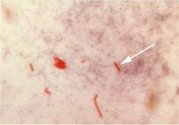Tuberculosis
Tuberculosis (commonly shortened to TB) is an infection caused by the bacterium Mycobacterium tuberculosis, which most commonly affects the lungs (pulmonary TB) but can also affect the central nervous system (meningitis), lymphatic system, circulatory system (Miliary tuberculosis), genitourinary system, bones and joints. more...
Tuberculosis is the most common major infectious disease today, infecting two billion people or one-third of the world's population, with nine million new cases of active disease annually, resulting in two million deaths, mostly in developing countries.
Most of those infected (90 percent) have asymptomatic latent TB infection (LTBI). There is a 10 percent lifetime chance that LTBI will progress to active TB disease which, if left untreated, will kill more than 50 percent of its victims. TB is one of the top three infectious killing diseases in the world: HIV/AIDS kills 3 million people each year, TB kills 2 million, and malaria kills 1 million.
The neglect of TB control programs, HIV/AIDS, and immigration has caused a resurgence of tuberculosis. Multiple drug resistant strains of TB (MDR-TB) are emerging. The World Health Organization declared TB a global health emergency in 1993.
Other names for the disease
- TB (short for tuberculosis and also for Tubercle Bacillus)
- Consumption (TB seemed to consume people from within with its symptoms of bloody cough, fever, pallor, and long relentless wasting)
- Wasting disease
- White plague (TB sufferers appear markedly pale)
- Phthisis (Greek for consumption) and phthisis pulmonalis
- Scrofula (swollen neck glands)
- King's evil (so called because it was believed that a king's touch would heal scrofula)
- Pott's disease of the spine
- Miliary TB (x-ray lesions look like millet seeds)
- Tabes mesenterica (TB of the abdomen)
- Lupus vulgaris (the common wolf - TB of the skin)
- Prosector's wart, also a kind of TB of the skin, transmitted by contact with contaminated cadavers to anatomists, pathologists, veterinarians, surgeons, butchers, etc.
The bacterium
The cause of tuberculosis, Mycobacterium tuberculosis (MTB), is a slow-growing aerobic bacterium that divides every 16 to 20 hours. This is extremely slow compared to other bacteria, which tend to have division times measured in minutes (among the fastest growing bacteria is a strain of E. coli that can divide roughly every 20 minutes). It is not classified as either Gram-positive or Gram-negative because it does not have the chemical characteristics of either, although it contains peptidoglycan in their cell wall. If a Gram stain is performed, it stains very weakly Gram-positive or not at all. It is a small rod-like bacillus which can withstand weak disinfectants and can survive in a dry state for weeks but, spontaneously, can only grow within a host organism (in vitro culture of M. tuberculosis took a long time to be achieved, but is nowadays a normal laboratory procedure).
Read more at Wikipedia.org



